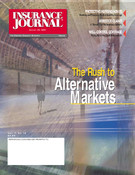In the last 18 months, rapidly escalating asbestos claims have caused several Fortune 500 companies to seek bankruptcy protection including Owens Corning (October 2000), Babcock & Wilcox (February 2000), Armstrong World Industries (December 2000), G.I. Holdings (fka GAF Corp. (January 2000), W.R. Grace (April 2001) and USG Corporation (June 2001).
With the major manufacturers of asbestos products in bankruptcy, asbestos plaintiff lawyers are now pursuing new industries where asbestos is a problem. For years, companies saw claims arise from plaintiffs who were exposed to asbestos during maritime activities in World War II. Today, companies that either manufactured or used small quantities of asbestos in their products, or those that had asbestos insulating their facilities are now facing claims.
Even companies that used contract workers could be swept into the courtroom because their contractors are not covered by workers’ compensation. These new defendants had either nominal or no asbestos liability claims in the past.
Recently, Tillinghast Towers-Perrin announced it has increased its estimates for the total cost of asbestos losses to between $55 and $65 billion. Although 25 years have passed since the peak usage of asbestos, claims continue higher than ever. Most epidemiologists believe that the claims are not going to disappear until 2050. How will companies combat asbestos-related complaints and ultimately stay afloat? “Their “life raft” is most likely contained in their own files – their historic insurance policies,” replies Lori Siwik, vice president and counsel for Risk International, a Houston-based risk management consulting firm.
Commercial general liability (“CGL”) policies have long provided broad coverage for property damage, bodily injury, personal injury and advertising liability. Most property and casualty companies wrote policies with split liability limits: one set of limits for products and completed operations, another set of limits for premises liability and other operations. Typically, the products and completed operations had an aggregate limit. Unlike products coverage, most CGL policies do not contain aggregate limits for premises operations.
The recent wave of asbestos claims has hit oil, chemical and steel companies, and utilities and railroads. Companies in those sectors should pursue coverage under the premises operations coverage in their CGL policies, advises Siwik. “The vast majority of claims against corporate America have been product claims. Many companies with historic asbestos liabilities have exhausted their products coverage. Companies should also look to first-party property policies- “premises operation” coverage within the CGL policies-and insurance of other companies such as contractors, subcontractors, property owners, architects and engineers,” she said.
“A company receiving asbestos liability claims should look at all possible insurance policies. Because asbestos exposures typically have occurred over time, insurance policies in place from the 1930s to the present may provide coverage for the asbestos liability claims depending upon the relevant time period for each claim,” states Siwik. Published reports put the total cost for asbestos losses at $200 billion in the U.S. with insureds picking up 39 percent of the costs, U.S. insurance companies absorbing another 30 percent while non-U.S. insurers would be responsible for the remaining 31 percent.
For those companies engulfed in increasing asbestos liability claims and for those that are just breaking the surf, the value of insurance coverage cannot be overstated. The insurance companies know that there is coverage for the asbestos liability claims and have set aside an additional $10.3 billion to pay for them. Insurance carriers have already paid $21.6 billion for asbestos claims.
Was this article valuable?
Here are more articles you may enjoy.


 Farmers Adjusters Cry Foul Over Workloads, Claims Handling in Letter to Regulators
Farmers Adjusters Cry Foul Over Workloads, Claims Handling in Letter to Regulators  ‘Great Resignation’ Enters Third Year as Workers Embrace AI, Upskilling, PwC Says
‘Great Resignation’ Enters Third Year as Workers Embrace AI, Upskilling, PwC Says  As Rates Rise, Majority of Homeowners Say Insurance Industry Is in Crisis: Survey
As Rates Rise, Majority of Homeowners Say Insurance Industry Is in Crisis: Survey  Let Good Adjusters, Not Expensive Lawyers, Make the Difference on Claims, CEO Says
Let Good Adjusters, Not Expensive Lawyers, Make the Difference on Claims, CEO Says 


